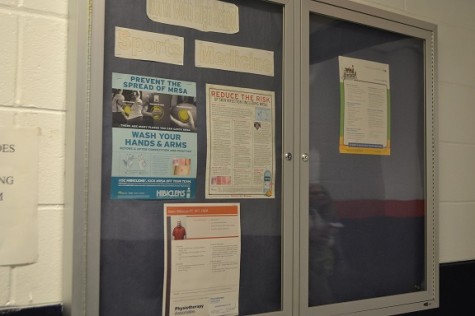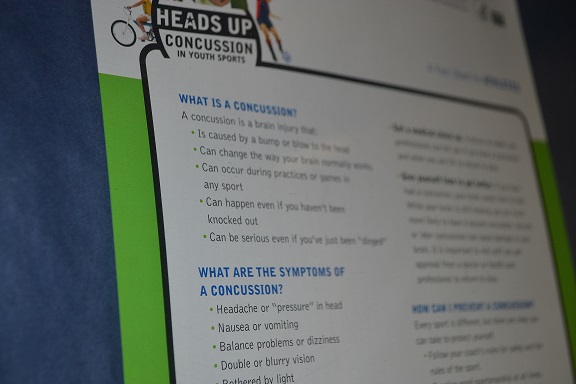Heads Up! Concussions tough to prevent while playing risky football
December 15, 2014
Football serves as a culturally important sport in America. People spend their Friday nights at high school football games, they invite their friends over on Sundays to indulge in the sport, and finish watching a game with their family before sitting down to Thanksgiving dinner. They enjoy every tackle, hit, and clash of helmets. The truth of the violence and injury sits at the back of their minds as they root for their favorite team.
The National Football League (NFL) stated in federal court documents that one out of every three players that have retired suffer from long-term cognitive problems, and the conditions are likely to arrive at “notably younger ages” than in the general population. Statistics like this make people think about the violence that occurs during a game and during full-contact practices. Imagine playing this sport without professional, high quality safety equipment or smashing helmets with someone that has a still-developing brain.
Although not as rough as professional football, playing for a high school team also involves serious risks. Tyler Lewellen, a defensive back for the Arlington High School team in California, died after sustaining a brain injury during a scrimmage at the start of last season. After that, the school started pushing for better helmets with sensors in them, and the junior varsity team was dropped. Students started to leave the team and those that stayed have not won a game yet this season.
Player safety has been a defining issue in recent years, and the increased public awareness takes a toll on participation in football teams. Football still remains the most popular high school sport in the United States, but recently participation has dropped. From 2008 to 2013, the amount of boys playing the sport fell by 17,000, while in other school-sanctioned sports it rose about 122,000.
Surveys, public icons, and NFL retirees discourage youth from playing football, making parents question the safety of the sport. A recent Marist College poll found that roughly one in three americans say that knowing about the damage concussions cause would make them less likely to let their sons play football.
“I never thought about how violent the sport is until I started seeing stories on the news of kids suffering from brain damage because of their participation on a football team. It is scary to know that at every game and every practice there is always a risk of serious injury. I would not let my son get involved in something that could put him at risk everyday,” said Shandra Cotter, parent to senior Tom Cotter.
Even President Obama has expressed doubts about letting his hypothetical son play the game. He compares the players to smokers and says, “At this point, there’s a little bit of caveat emptor. These guys, they know what they’re doing. They know what they’re buying into. It is no longer a secret.”
Obama also mentions that, one day, the beloved game will have to change. Although it may not excite viewers as much, football will someday have to take a turn more toward nonviolence, or at least find new ways to protect the athletes. The protection of high school players could start with better safety equipment, but coaches and students usually have trouble finding the money needed for high-end helmets and shoulder pads.

Posters by the gym warn student players of injuries that may occur on the field. They list the signs and symptoms of concussions.
One thing that sets high school football safety apart from that of a college or professional team: the budget. Due to the lack of funding, high school teams cannot afford the high quality safety equipment that keep professionals standing.
Many sporting goods stores sell top of the line helmets, shoulder pads, and face masks, but they can become extremely expensive. The helmets with the best safety features cost up to three hundred dollars. The best face masks cost around seventy dollars, and shoulder pads are around two hundred. These helmets and pads provide essential protection from injuries, but they also need to be replaced frequently.
Kevin Bittinger, athletic director of Hernando High School in Florida, said he could easily spend fifteen thousand dollars on pads alone, but the team has only a five thousand dollar budget. The pay-to-play fee ordered by some public schools requires students to pay an average of only one hundred dollars every season. Unless donated to the school, most teams do not have the money to go above and beyond with their safety equipment.
The larger budget of a college team allows them not only safer equipment, but also trained specialists and healthcare workers. They pay them to come to practices and games, so that, in case an injury occurs, they would be able to treat someone immediately instead of having to wait on an ambulance.
College and professional teams also pay for athletic trainers, who can help diagnose any issues and work with physicians to treat players. According to the National Athletic Trainers’ Association, however, only thirty-nine percent of public high schools have access to a full-time certified athletic trainer, and thirty percent of schools have no training services whatsoever.
Despite the statistics and surveys discouraging the game, football still remains the most popular sport in the United States. Players know the risk they take when they step out onto the field just as parents know the risk of signing their child up for the team at school, but something about the football culture and unity of the team makes people forget about the dangers of playing.


